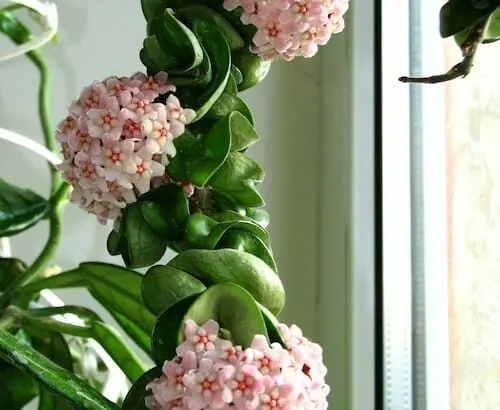You want to know more about Hoya carnosa copmacta care and get more information on the Hindu Rope plant.
In this article, I will detail how I care for my Hoya carnosa compacta.
Hoya carnosa compacta Takeaways
| Species | Hoya carnosa compacta |
| Synonyms | Hindu Rope Plant, Krinkle Kurl, Rope Hoya, Hoya Hindu, Hoya Compacta, Hoya Krinkle, Hoya Hindu Rope |
| Family | Apocynaceae |
| Genus | Hoya |
| Growth | Trailing, Spreading |
| Height | 1.5 foot |
| Width | 2.5 feet |
| Soil | Well-draining soil using peat, perlite, orchid bark |
| Watering | Every 7-14 days |
| Light | Bright indirect |
| Temperature | 60-70 °F to 90 °F (16-21 °C) |
| Humidity | 40-60% |
| Fertilizer | Fertilize every two months in spring and summer |
| Propagation | Stem cuttings |
| Toxicity | This plant is non-toxic to cats and dogs as well as humans. |
Table of Contents
Hoya carnosa compacta Care
To care for Hoya carnosa compact, use a fast-draining mixture of potting soil. Water once the top 2-3 inches of the soil are completely dry and provide bright indirect light. A daytime temperature of 70°F (21°C) or above is ideal. The perfect humidity is between 40-60%. Fertilize every 2 to 3 months using a liquid fertilizer.
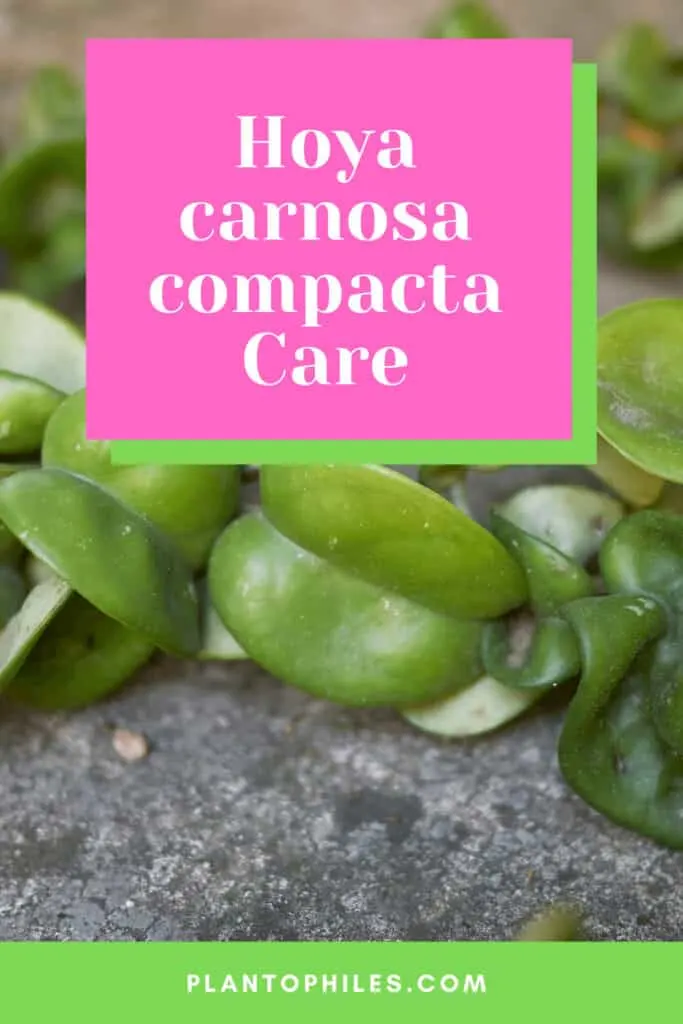
Hoya carnosa compacta (Hoya Hindu Rope)
Hoya carnosa compacta is an epiphytic evergreen semi-succulent vine that originated from East Asia and Australia.
According to the University of Florida. The Hoya plant family has up to 300 species, and the Hoya carnosa compacta is a very popular species, also called Hindu Rope Plant or Krinkle flower.
It is a very versatile plant that grows slowly. You can enjoy the magnificent lush green foliage for several years with minimal attention.
Like most other Hoya Species, the Hoya carnosa compacta is simple to care for.
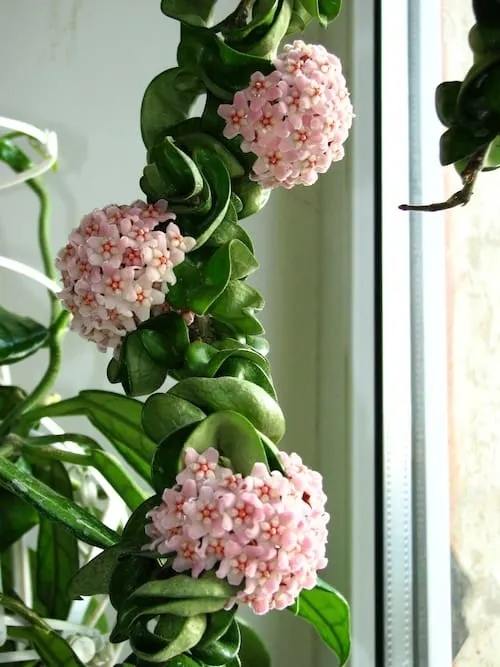
The Hoya Compacta has solid, dark green, or variegated leaves and is perfect for high locations such as ledges and hanging pots that show off the stunning trailing vines.
You can add beautiful hanging baskets on a balcony, deck area, or summer patio.
This unique plant has curly leaves and vines similar to thick ropes. The leaves of the Hoya Compacta have a glossy or waxy texture.
The Compacta Variegata has the same twisted and curled leaves as the classic Hoya Compacta; the only difference is that the leaves have creamy white or pink variegation.
Hoya carnosa compacta are known by several other names, such as Porcelain Flower, Hindu Rope plant, Krinkle Kurl, or Wax plant.
Each name represents a unique feature of the Hoya compacta plant.
The 200-year-old popularity of the Hoya compacta plant as a houseplant is attributed to its ease of care, distinctive appearance, and attractive sweet-smelling blooms.
Its nectar can attract beneficial wildlife, like honeybees and butterflies, when grown outdoors.
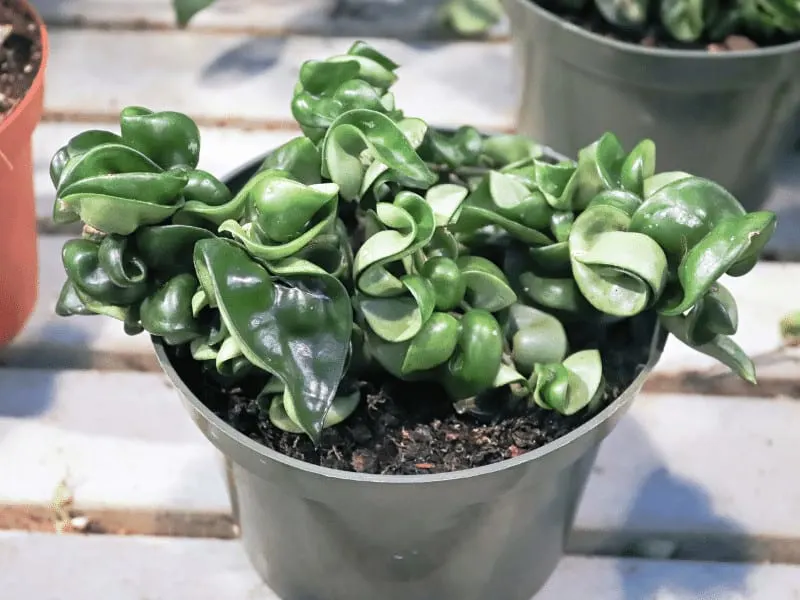
Hoya carnosa compacta Care Guide (Hoya Hindu Rope Care)
The growing period for the plant starts in mid-spring and continues throughout the summer season, and the plant needs special attention during that period.
This tough, robust houseplant can adapt to many different indoor living conditions.
This article has all the steps for Hoya carnosa compacta plant care to help it produce long-lasting foliage and blooms.
1. Hoya carnosa compacta Soil
Grow the Hoya compacta in a fast-draining mixture of potting soil that is lightweight and well-aerated. Choose a small pot with drainage holes that holds the roots of the Hoya Compacta tightly packed.
It is crucial to mention that due to the epiphytic nature of the Hoya Compacta, the roots need plenty of airflow for the plant to survive. Therefore the main criteria for a successful potting mix are good drainage and aeration.
This epiphytic plant can thrive in any general-purpose commercial potting mixture but cannot tolerate wet or soggy soil. You can add perlite to improve the drainage of the soil.
You can also create your well-aerated potting mix using 1/3 peat, 1/3 perlite, and 1/3 orchid mix (bark, perlite, or charcoal).
Use a coarser potting mixture for a humid climate to ensure good drainage and drying conditions.
Use a finer potting mixture to dry slowly and retain more moisture for a dry climate.
You should refresh the soil every two or three years for healthy growth.
Hoya Compacta is mostly used indoors, but you can also plant it outdoors. For outdoor planting, a USDA hardiness zone 10-12 is recommended.
2. How to water Hoya carnosa compacta
The Hoya compacta are semi-succulent, so they can survive with minimal watering. You should maintain slight moisture in the potting soil. Inspect the soil’s top 2-3 inches before watering or use a moisture meter.
In summer and spring, the plant is actively growing; therefore, it needs sufficient water. It should be watered deeply and regularly in the growing season, but only when the soil is dry.
The plant is resting in winter, so you can reduce the watering.
To water, the Hoya Compacta use the flood and drain method, i.e., flood the pot with water and allow the excess water to drain out from the pot. If you use a watering tray or sink, don’t leave the plant in water for more than 15 minutes.
Always allow the surface of the potting soil to dry out between waterings. The amount and frequency of watering also depend on the air temperature and humidity levels.
Drainage is critical for the Hoya compacta; the plant may drop flower buds if the soil remains soggy.
At the same time, excessively dry soil for an extended period may also cause the plant to drop buds.
The plant can tolerate short dry periods because semi-succulent vines are good at storing moisture. So even if you forget to water the plant once or twice, it still has some moisture stored to survive.
Overwatering is one of the common reasons for dying Hoya compacta. The epiphytic nature of the plant allows it to draw moisture from the air; therefore, in humid conditions, the plant needs to be watered less.
3. Best Light for Hoya carnosa compacta
Bright indirect light is best for the optimal growth of the Hoya carnosa compacta plant. Choose an indoor position near a window providing plenty of indirect bright sunlight.
The plant cannot tolerate direct sunlight and high heat, which will scorch the flowers and leaves.
6 hours of bright but indirect sunlight are recommended for the healthy growth of hoya plants. Morning sunlight is preferred for houseplants, as it will not scorch the plant leaves.
This plant can even grow in low light conditions, but the growth will be very slow, and the plant may not have any blooms.
Lighting conditions can significantly impact the blooming phase of this plant. Good lighting is very crucial for producing flowers on the Hoya Compacta.
If you are keeping the Hoya compacta outside, choose a position with partial shade. Ensure the plant is not exposed to direct sunlight for an extended period.
Too much sunlight exposure can cause yellowing of the foliage. Move the plant away from direct sunlight if you notice any yellowing leaves.
If you are using artificial or fluorescent lights, the plant should be exposed to the lights daily for around 14 hours.
If you want to encourage blooms, leave the plant under artificial lights for up to 16 hours.
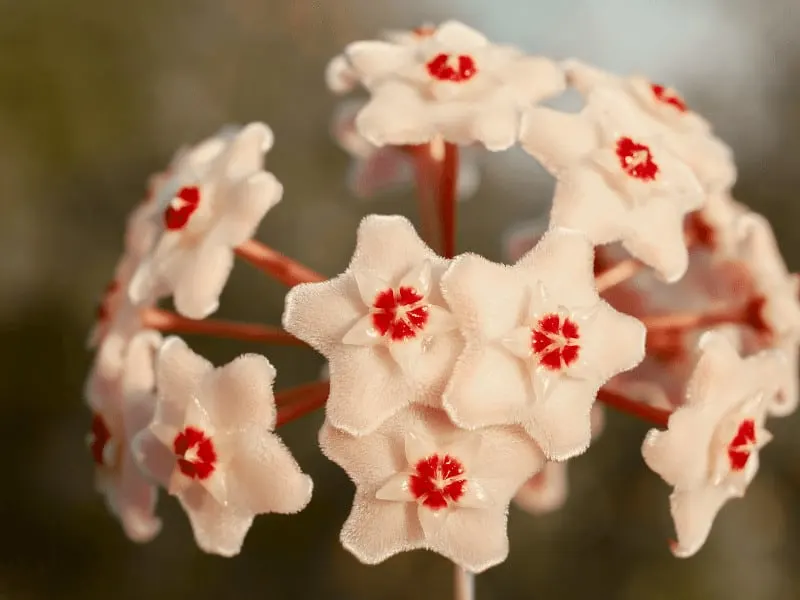
4. Hoya carnosa compacta Temperature
This plant likes continuous warm indoor temperatures. At day, maintain a temperature of about 70°F (21°C) or above; at night, 60-65 oF (16-18 degrees Celsius) is ideal for the Hoya compacta plant.
The minimum temperature should always be above 50 oF (10 degrees Celsius).
This plant is a favorite houseplant because it typically grows well in the usual indoor temperature.
This plant can be kept outdoors in warm areas only if the outdoor temperature does not drop below 50 oF (10 degrees Celsius).
The Hoya compacta plant does not do well in cold temperatures. So if you plan to spend the winter away from home, you must leave the heating on or make any other arrangement to keep your plant happy and comfortable in your absence.
Keep the Hoya Compacta plant away from hot radiators or cold drafts to protect it from sudden temperature changes.
5. Ideal Humidity for Hoya carnosa compacta
The Hoya compacta is native to warm and humid climates; therefore, this plant enjoys higher humidity than the average indoor level.
The waxy leaves will appear glossy and healthy in the right humidity conditions. It’s time to increase the humidity when they look withered or dry.
You can increase the indoor humidity level by using a humidifier. An air humidifier will keep the air around the plant moist enough to grow lush leaves and flowers.
Alternatively, you can place the pot on a rock-filled tray with water to achieve the right humidity level, i.e., between 40-60 %.
In very dry conditions, you can mist the plant daily to increase humidity or group several plants together.
This plant craves more humidity than most other indoor houseplants. You can consider placing the plant in a bathroom or kitchen where the humidity level is higher than in other places.
To take care of your Hoya Compacta plant during winter, you must reduce watering and increase humidity.
Because in cold months, the central heating will cause the air to dry quickly. Reducing the watering during winter will also prevent the soil from becoming waterlogged or too damp.
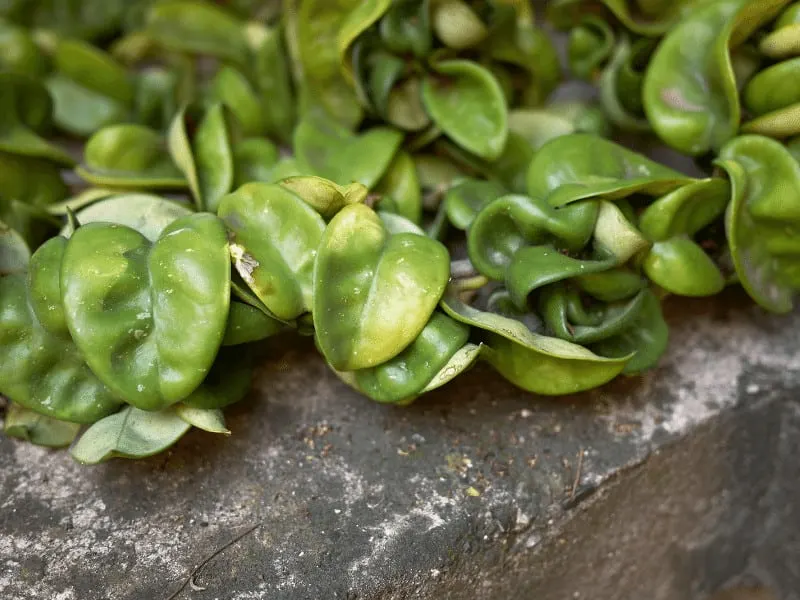
6. How to fertilize Hoya carnosa compacta
Hoya Compacta is a light feeder and enjoys a small dose of fertilizers in the growing period.
Feed the Hoya Compacta plant with a diluted water-soluble fertilizer every 2 to 3 months in spring and summer.
The plant does not need heavy fertilizer feeding for healthy growth. Don’t fertilize the plant in the resting phase, i.e., from fall to winter.
If the new leaves are dark green and small, reduce the fertilizer application or dilute the fertilizer solution. Use the fertilizer according to the label, or dissolve ¼ teaspoon of fertilizer in 1 gallon of filtered water.
I would recommend using a fertilizer high in potassium to encourage beautiful blooms on the Hoya compacta.
Be wary of overfertilizing; it can severely damage the plant, it causes dry, crinkled leaves, and make the new leaves smaller.
A crusty white residue on the soil surface usually denotes overfertilization.
If your plant is victim to overfertilizing, thoroughly flush the plant with water or repot it in a new soil mixture.
7. How to pot Hoya carnosa compacta
The Hoya Carnosa compacta make a great hanging plant. These slow-growing vines rarely need repotting as there are fewer chances of the plant outgrowing the pot.
Use a small-sized pot to minimize the risk of root rot, as the potting mixture will dry out more quickly in a small pot.
It will provide enough space for the roots while still keeping them packed. Drainage holes are a must for this plant.
You need to repot the plant if one of the following happens:
- The soil dries out more quickly after watering
- The potting soil has become very compact. Hence the roots are suffering from a lack of oxygen
- The roots are clogging the drainage holes
- The general health of the plant is declining
To repot Hoya carnosa compacta, carefully remove it from the pot and remove the excess soil from the roots. Check for damaged or dead roots and prune them with sterilized pruning shears. Transfer it to a container that is 2″ larger than the previous one.
You can repot the Hoya compacta plant anytime between spring and mid-summer. Avoid repotting the plant when it’s blooming because it can damage the flowers and lose healthy blooms.
When repotting, always be cautious and protect the roots. The roots of this plant are tangled, and they should be kept the same in the new container.
8. Blooms
Star-shaped flowers of the Hoya carnosa compacta are the most attractive feature of this plant. The beauty and perfection of the tiny star-shaped flowers is why this plant is famous as a porcelain flower.
This Hoya species takes a few years to flower, so be patient.
The mature plant will produce beautiful blooms in early spring and summer with correct lighting conditions. Each flower has two stars, the inner star is known as the corona, and the outer star is corolla.
The pinkish-white flowers appear in clusters; each plant can produce up to 40 flowers. The flowers last for 2 to 3 weeks.
They come in a range of colors with a heavy and sweet fragrance. The flowers bloom from the spurs, which are small leafless stems.
With the proper nutrition and water, some plants take 1 year, while others take up to 3 years to flower. The most common reason for failed blooming is insufficient light.
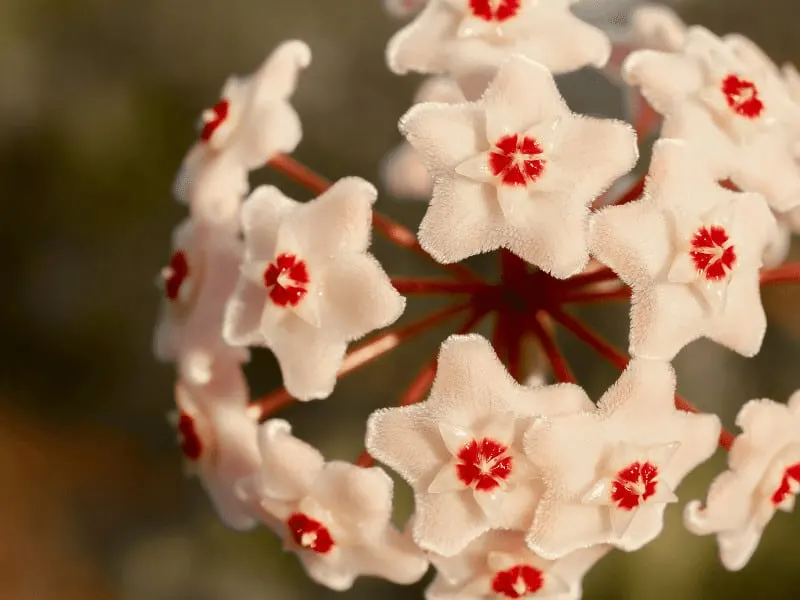
9. How to prune Hoya carnosa compacta
Pruning is an additional step in Hoya compacta care, only needed to improve the plant’s overall appearance or manage its size. While pruning the plant, do not remove any stems with spurs because this will reduce the number of blooms.
Spur is the tip of the peduncle where the flower grows. In the blooming season, flowers grow from both old and new spurs. And old spurs are believed to produce the largest blooms on the vine.
You should prune the plant in the spring to allow it to recover from pruning stress or shock. You can cut any dead or damaged stems. Pinch off yellow, brown, or dead leaves to keep the plant looking tidy and attractive.
Properly sanitize the pruning shears to prevent infections. Soak the shears in household disinfectant for 5 minutes and rinse them with hot water later. After pruning, you can use the stem cuttings for propagation.
10. Hoya carnosa compacta Propagation
The most effective way to propagate a Hoya carnosa compacta is via stem cuttings:
- Using clean pruning shears, remove a section of 3-4 inches from the tip of the plant(just below the node) by cutting at an angle. Choose a section that has at least one pair of leaves.
- Remove all the leaves from the lower end of the cutting and allow it to dry. The white latex will harden overnight.
- You can dip the stem cutting in the rooting hormone to encourage growth, but it’s optional.
- Now place the bottom part of the cutting in water. Do not immerse the leaves in the water.
- Or place the cutting in a small pot with a lightweight moist growing medium.
- Cover the potted plant with a plastic or propagation bag to help retain moisture.
- Position the cutting in a warm shaded position for several weeks.
- After a few weeks, you will notice new growth above the soil; now, you can transplant the Hoya Compacta to a new pot or container.
Other ways of propagating Hoya compacta are leaf cuttings, seeds, and air layering.
Common Pests and diseases for Hoya carnosa compacta
This plant is susceptible to common houseplant pests such as mealybugs, spider mites, and aphids.
Mealybugs feed on the stems of plants and suck out the sap, leading to decaying, weak branches and stunted growth.
Mealybugs will hide on the inner side of the curled vines, so check the vines regularly to spot any infections.
Aphids also damage new growth and are mostly found near flowers.
The waxy curled foliage is the ideal hiding spot for spider mites. You should regularly inspect the leaf nodes and leaves for any infections.
Spider mites are so small that they’ll go unnoticed until the plants are severely damaged.
The initial symptoms include new leaves cupping downward, wrinkling, and stunted growth.
You can treat mealybugs, aphids, and spider mites with soap. Mix 2 to 5 tablespoons of dishwashing liquid in 1 gallon of water.
Now store this solution in a spray bottle. Spray the solution on the undersides of the leaves. Repeat the spraying every two weeks until the issue is resolved.
Another organic and cost-effective solution for these pests is neem oil. Spray the curled part of the leaves regularly with neem oil.
Botrytis is a fungus that causes grayish areas on the leaves. Mostly the center leaves are infected where moisture levels are the highest.
When this happens, remove the plant from the humid area and cut any damaged parts of the plant.
After this, repot it in a new pot with fresh soil and spray a fungicide on the entire plant.
If you want an organic treatment instead of chemical fungicides, you can use a mixture of baking soda and water.
Tips for an Unhappy Hoya carnosa compacta
Hoya Carnosa Compacta is one of the most interesting hanging plants with distinctive waxy flowers and curling foliage.
If you are planning to place one in your home, follow the simple Hoya Compacta care tips given below:
- You should not rotate, repot or move the Hoya carnosa Compacta after the flower blooms, this can disturb the growth of the flowers, and they may not survive the transition.
- Avoid overwatering or overfeeding the Hoya Compacta plant in winter.
- Hoya Compacta should be kept in small pots to prevent overwatering.
- Cleaning the leaves often can help to discourage pests.
- Avoid transplanting mature Hoya Carnosa Compacta as this may stress the roots of the plants.
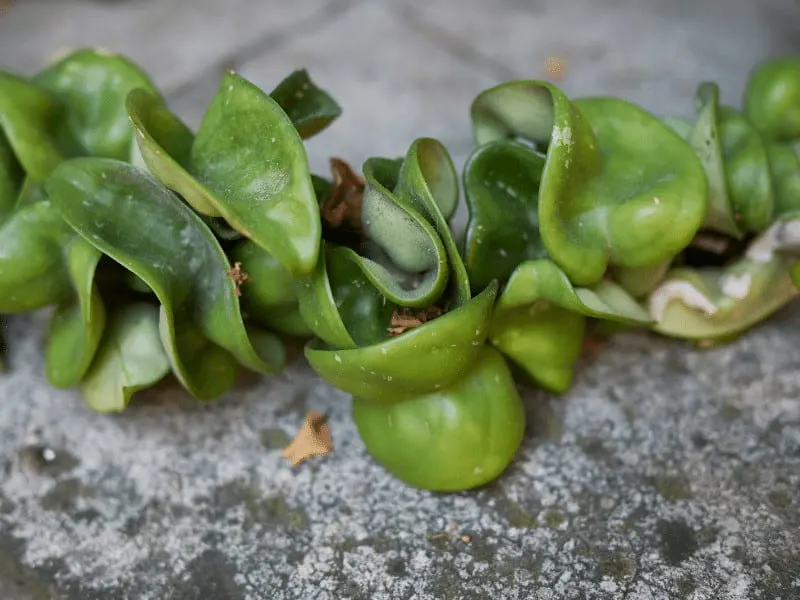
Frequently Asked Questions about Hoya carnosa compacta
Why is the plant famous as a Hindu rope plant?
The leaves of Hoya Compacta are tightly packed, resembling a rope, and the plant is native to East Asia; therefore, it is famous as a Hindu Rope plant among gardeners.
When is the best time to repot the Hoya Compacta?
Like every other indoor houseplant, the best time to repot Hoya Compacta is during the growing phase, i.e. spring or summer. Avoid transplanting when the plant is blooming; this can shock the flowers.
Is the Hoya Compacta poisonous?
No, the Hoya Compacta plant is a safe houseplant for indoor spaces with pets or kids. The leaves are not toxic and do not pose any health issues.
Is Hoya Compacta drought tolerant?
Yes, Hoya Carnosa Compacta is typically accustomed to short periods of drought in its native habitat; for this reason, it can withhold water for 4-5 weeks in spring.
Conclusion About Hoya carnosa compacta care
To care for Hoya carnosa compacta, provide a humidity between 40-60% and bright indirect light. A well-draining soil mix is best. Water once the top 2-3 inches of soil (5.0-7.5cm) are dry. Fertilize every two to three months using a diluted liquid fertilizer.

Daniel has been a plant enthusiast for over 20 years. He owns hundreds of houseplants and prepares for the chili growing seasons yearly with great anticipation. His favorite plants are plant species in the Araceae family, such as Monstera, Philodendron, and Anthurium. He also loves gardening and is growing hot peppers, tomatoes, and many more vegetables.

